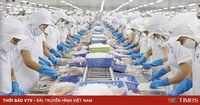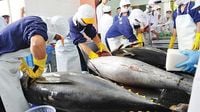On May 9, 2025, the Ho Chi Minh City Investment and Trade Promotion Center (ITPC) collaborated with the US-Vietnam Business Council (UVBC) to host a significant conference titled "US Countervailing Duties: Preparation of Vietnamese Enterprises." This event aimed to equip Vietnamese businesses with the necessary knowledge and strategies to navigate the complexities of US trade policies and tariffs.
Cao Thi Phi Van, Deputy Director of ITPC, emphasized the importance of the US market, stating, "The United States is currently Vietnam's largest export market." Over the past five years, Vietnam has maintained a substantial trade surplus with the US, which has grown from approximately $63.4 billion in 2020 to nearly $106 billion in 2024.
The Vietnamese government is actively preparing for negotiations with the US, focusing on achieving balanced and sustainable trade while protecting the legitimate rights and interests of Vietnam, in line with international agreements. Van noted, "Despite the potential countervailing duties imposed by the US, this conference will help exporters recognize and seize new opportunities."
In light of the evolving global economy, the Ho Chi Minh City government and local businesses are implementing various initiatives to diversify markets and enhance the quality and competitiveness of their goods and services. This includes leveraging the 17 Free Trade Agreements (FTAs) that Vietnam has signed.
Joe Trung Trinh, Managing Director of UVBC, urged Vietnamese exporters to proactively develop plans for all possible scenarios. He stated, "Businesses must be ready to adapt to any changes in the market, especially with the uncertainties surrounding US tariffs." Jenifer Diaz, an international trade lawyer, added that high tariffs imposed on China create specific opportunities for Vietnamese goods entering the US market.
Diaz emphasized the need for Vietnamese exporters to remain vigilant and continuously update their knowledge regarding US regulations. She explained that even if goods are exported via a US intermediary, they are still subject to stringent customs reviews. Thus, exporters must ensure they have all necessary documentation, including proof of origin for both finished products and raw materials, readily available for US Customs.
Dr. Son Tran, an Assistant Professor of Business at SUNY Cobleskill and a Business Development Advisor for UVBC, outlined several strategic directions for Vietnamese businesses. Firstly, he stressed the importance of strict compliance with regulations, including thorough supply chain documentation and transparent origin labeling. Secondly, he advised companies to shift from Original Equipment Manufacturer (OEM) and Original Design Manufacturer (ODM) models to Original Brand Manufacturer (OBM) models, focusing on brand development and product innovation.
Tran also highlighted the necessity of active engagement with trade associations and policy-making bodies, asserting that Vietnam must position itself as a reliable trade partner. He suggested that Vietnam should develop a robust national branding strategy to transition its image from a low-cost producer to a trusted supplier of unique, high-value products.
In conjunction with the conference, the Vietnam Association of Seafood Exporters and Producers (VASEP) reported that seafood exports in the first four months of 2025 reached $3.3 billion, a 21% increase compared to the same period last year. Specifically, shrimp exports surged to $1.27 billion, marking a 30% rise, while catfish exports reached $632.7 million, up 9%.
However, the US market, a crucial destination for Vietnamese seafood, is facing considerable challenges due to new tariff policies. VASEP anticipates that export turnover to the US may increase by 10-15% in May and June 2025, as businesses ramp up shipments before the tariffs take effect.
Tran Thuy Que Phuong, Deputy Secretary General of VASEP, expressed optimism about the outcomes of ongoing negotiations between the Vietnamese and US governments. She stated, "All businesses are relying on the results of the negotiations, hoping for a favorable tax rate that aligns with those in competing markets like Ecuador, India, Thailand, and Indonesia."
In response to rising tariff pressures and escalating logistics costs, many companies are adjusting their strategies to focus on deeply processed products and expanding into new markets, particularly in the EU, Japan, and ASEAN regions.
Vo Van Phuc, General Director of Vietnam Clean Seafood Company, shared insights into their market strategy, saying, "We have developed a market strategy to diversify, ensuring that the US maintains a certain market share. This will allow us to pivot as necessary. While we expect some decline, we are confident in our ability to recover gradually."
The Ministry of Agriculture and Rural Development is also pushing for a comprehensive restructuring of the seafood industry, focusing on improving farming standards, quality control, and expanding market access while negotiating trade agreements with the US and working to resolve the yellow card issued for illegal, unreported, and unregulated fishing (IUU).
Phung Duc Tien from the Ministry of Agriculture emphasized the importance of synchronizing market and production strategies under government guidance. He noted, "The market acts as a driving force, while production serves as the push. Both must work in harmony to ensure success in international integration and to remove the IUU yellow card as quickly as possible, allowing for broader seafood export opportunities, particularly targeting the Netherlands in the near future."
Moreover, a credit package of 100 trillion VND is expected to provide vital resources for businesses to invest in farming areas, upgrade technology, and expand production scale, laying the groundwork for sustainable growth throughout the year.






